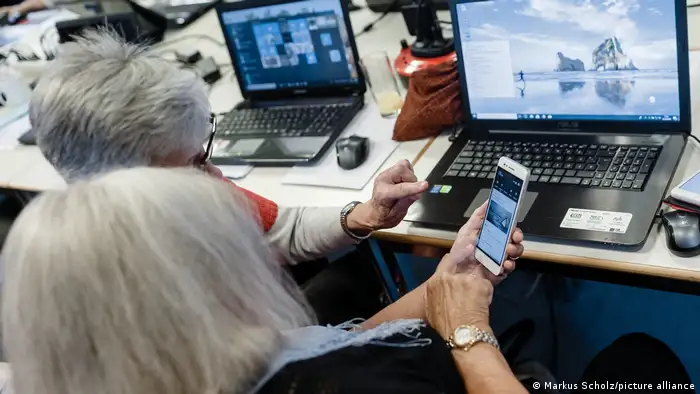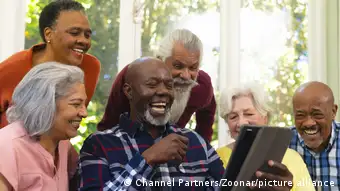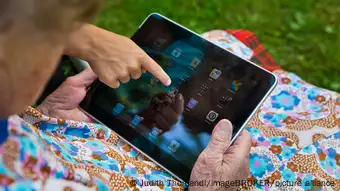Media and information literacy for seniors
Digital Media and Information Literacy for adults over 60: Five insights for media development
Digital Media and Information Literacy is crucial, and not just for youth; older adults are also active online. So what has research shown that's important when considering the digital media literacy of people over 60?
As media and information sources and distribution channels have increased over the past decades, Media and Information Literacy (MIL) has become more important than ever. MIL aims to equip people with the competencies and skills to engage effectively and responsibly with online media and information systems.¹ Digital sources in particular have grown exponentially, making the need for MIL skills on the digital front – Digital Media and Information Literacy (DMIL) – increasingly urgent.
In many regions of the world, not only young people access digital media. Older adults are also turning to digital media and information sources; sometimes out of necessity, such as when government services are moved online, and sometimes for personal interests, like keeping in touch with family members via social media. However, it is often thought that older adults are less skilled, less capable and in need of interventions to get up to speed with digital media. This raises the question as to whether people over 60 have the competences needed to deal with digital media. And are they sufficiently taken into consideration in MIL and DMIL initiatives regarding media development approaches?
To answer these questions, we reviewed available MIL studies on adults over 60. Three limitations quickly became clear: First, not many studies look at the media literacy of older people. Second, many initiatives for older people focus on digital media literacy rather than on media literacy in general. Third and most important, most of the studies so far concentrate on countries in the Global North. As a result, we do not have a complete picture of the situation worldwide.
Important aspects worth keeping in mind when thinking about enhancing older adults’ digital media and information literacy:
1. Adults over 60 are not a homogenous group
In general, people over 60 are categorized as older adults based on their chronological age. Often, distinct age demarcations for digital literacy initiatives end at 60 or 65, with those who are older being lumped together as one group e.g. "over 65" or "60 +". These older adults are often seen as being less skilled, less capable and in need of interventions to get up to speed with digital media. However, our review of studies on digital media literacy among this age group revealed that this neat categorization of skill levels based on chronological age does not hold for DMIL. Rather than being a group that's generally techically challenged, older adults have varying levels of knowledge and skills in using digital media, and different motivation and levels of interest when using digital technology. Even research conducted within a country has found digital media use to be quite diverse among this group.
In Sweden, for example, one of the most digitally connected countries in the world, adults in the 80-85 age bracket were found to use the Internet much less frequently than those between the ages of 60 and 80.² Not surprisingly, by 2014, the Internet use of those between the ages of 60 and 64 was already on par with the rest of the population. In Iceland, research found³ that in 2012, older adults looked for information on the Internet more than in 2002, but that the age group between 60-67 was more critical of the information in 2012 compared to 2002. These findings underline the fact that within the "over 60" group, digital skills vary both in terms of access and in evaluating information received via digital means.
2. Age is not the most important factor in determining digital media use
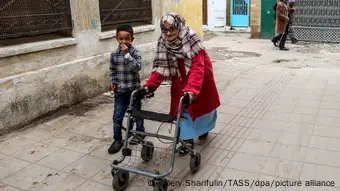
Physical and mental health, as well as the social context are important factors in determining digital media use
The review showed that age is NOT the most important factor in determining digital media use among older adults. Instead, social characteristics and factors such as the level of education seem to matter more. In one study, older adults with a lower education, poor health, memory issues and living alone were found to be most susceptible to digital exclusion.⁴ A German study⁵ of adults between the ages of 65 and 90, found that the younger males who held an academic degree tended to have broad and more skilled Internet use. Similarly, a Swedish study⁶ showed that for people aged between 66 and 85, general Internet habits, sex and political interests were the most determining factors as to whether people accessed news online. A cross-national study⁷ comparing seniors in Canada, the Netherlands, Spain and Sweden found that age seemed to be the least significant factor in determining smartphone use patterns. Rather, national policies, sociocultural context and education level seemed to be more significant. Different groups among older adults used the Internet (via their smartphones) for different functions ranging from games and leisure to management tasks such as Internet banking.
What does this tell us? First, while age is not the key determinant of the level of digital media and information literacy, it can certainly amplify the difficulties of information access and interpretation for vulnerable groups (e.g. those with limited education and less supportive social contexts). Secondly, (formal) education matters for the use of the Internet. Considering that literacy levels vary across the globe, with females often disproportionately less educated than males, it is important to first consider increasing basic literacy, even while working on enhancing digital literacy skills. Furthermore, a special focus on marginalized or otherwise disadvantaged groups for DMIL is important. It is well worth considering approaches to address social inequalities in addition to approaches enhancing digital and media information literacy. Thirdly, education, physical and mental health, and social contexts all contribute to the competent use of digital media. As such, it is important to develop holistic interventions that look at the whole person and their social circumstances, including national policies in their context, and not just at their digital media access and use.
3. Digital media use and social ties go hand in hand
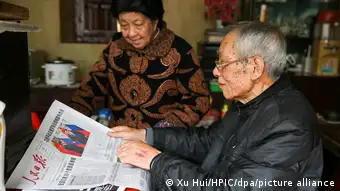
An elderly couple reading the newspaper in Rugao, China, a city renowned for the longevity of its residents
In a UK study⁸ to assess an initiative equipping older adults who live in the same neighborhood with digital skills, it became clear that in a geographically small context, meeting face to face remains important and that physical interactions are in fact preferred to meeting online. Similarly, in a study carried out in rural Finland,⁹ researchers found that digital competence is best understood as a shared skill experienced in one’s social setting consisting of elderly couples, families with three generations and informal networks of villagers, rather than as an individual characteristic.
As a result, digital technology and its use should be seen as part of one’s repertoire of social ties, such that it can in some way fit into pre-existent social ties and habits. It seems to work best complementing other interactions rather than replacing them. When thinking of DMIL programs in particular communities, it is important to map out the existing habits and ties of the older adults in order to better understand the kind of digital media competences that can add value to their contexts that already exist. Given that they may have more time on their hands compared to younger groups, older adults may be more inclined to engage in physical rather than virtual interactions. This is of value in itself and should not necessarily be replaced by digital skills.
4. The need to acquire digital skills should not be assumed
While DMIL is thought of as an essential set of competencies to ensure digital citizenship, it is important to first consider whether all older adults are willing to acquire these skills and engage in the digital world.
Separate studies in Italy,¹⁰ Taiwan¹¹ and Australia¹² all showed that sometimes older adults are not open to learning more digital skills or using them. For some, the fact that their younger family members could carry out digital tasks on their behalf was reason enough to not want to learn new skills at an advanced age. For others, there was a reluctance to engage in social media cultures such as taking selfies because it went against their values, interests and needs. For yet another group, learning digital technology and using multimedia messages was linked less to age, education or gender, but more to an accepting attitude towards technology and the perceived usefulness of the new skills to daily life.
The above findings show that digital competences are not a one-size-fits-all, and that there needs to be a clear added value to daily life to justify having to learn new digital skills. Older adults are sometimes also reluctant to engage in some social media cultures because they go against their values, interests or needs. This highlights the fact that digital inclusion and participation are not just about access, use or skills; non-usage associated with social and generational norms is a reality that needs to be considered.
5. Diverse media use, varied impact
Like other age groups, adults over 60 use multiple media formats and not just digital media. The impact of this diverse media use varies depending on people's prior media literacy skills, the competences they have and the content they can access.
For instance, two separately conducted studies on the media repertoires of older adults had quite different results. In one study,¹³ carried out in the USA, using television as a primary news source was linked to more resilience against online misinformation. In Ukraine, however, a study on similar aspects¹⁴ had the opposite results: The study showed that consuming old media, particularly Russian television, was linked to more susceptibility to disinformation and misinformation. As such, it is not about which type of media channels are accessed, but about the content they offer. In a Korean study,¹⁵ lower digital media literacy was linked to higher levels of loneliness with increased social media use. And in Spain,¹⁶ the ability to access, analyze, create, and share various types of messages in different formats across these multiple media was found to be fundamental for social participation and personal fulfilment of senior citizens. As such, digital media literacy seems to matter as a factor in whether media access has positive or negative impact.
So, what does all this mean for media development interventions in the field of DMIL?
First of all, targeted approaches tailored to different sub-groups within the broader ‘over 60’ category would be most appropriate. Differences including education level, existent internet habits, prior media literacy, and, importantly, social inequalities, should all be taken into account. A nuanced rather than a one-size-fits-all approach is key.
Secondly, DMIL may not be the best fit in some situations. Ascertaining the usefulness of DMIL for older adults’ daily lives in a particular context is an important first step in deciding whether to implement an intervention or not. Interventions for people over 60 may be most suitable with a broader focus encompassing a range of MIL skills rather than focusing solely on DMIL skills.
Thirdly, efforts to enhance the DMIL of older adults should not only focus on enhancing their individual skills, but should also take into account the broader information environment they live in. While individual competences matter, supporting an enabling environment is equally important.
In conclusion, while there are still gaps in what we know about older adults and digital media literacy, these reflections underline that we need a more nuanced view of people over 60 and what they bring to the table. Older adults are not always in need of interventions or disadvantaged when it comes to using digital technology. On the contrary, they have strengths that are often overlooked and untapped including more time and more life experience. Any attempts to enhance their DMIL should take a nuanced approach that considers their contexts, social characteristics, pre-existing knowledge and levels of interest in gaining such competencies.
_______________________________
¹ https://akademie.dw.com/en/media-and-information-literacy/a-18406566
² Bergström, A. (2017). Digital equality and the uptake of digital applications among seniors of different age. Nordicom Review, 38, 79–91. https://doi.org/10.1515/nor-2017-0398
³ Pálsdóttir, Á. (2016, January 3). Senior citizens, media and information literacy and health information. https://doi.org/10.1007/978-3-319-28197-1_24
⁴ Heponiemi, T., Virtanen, L., Kaihlanen, A.-M., Kainiemi Päivikki Koponen, E., & Koskinen, S. (2022). Use and changes in the use of the internet for obtaining services among older adults during the COVID-19 pandemic: A longitudinal population-based survey study. New Media & Society, 14614448221097000. https://doi.org/10.1177/14614448221097000
⁵ Leukel, J., Schehl, B., & Sugumaran, V. (2021). Digital inequality among older adults: explaining differences in the breadth of internet use. Information, Communication & Society, 26, 2023(1), 139–154. https://doi.org/https://doi.org/10.1080/1369118X.2021.1942951
⁶ Bergström, A. (2020). Exploring digital divides in older adults’ news consumption. Nordicom Review, 41(2), 163–177. https://doi.org/https://doi.org/10.2478/nor-2020-0021
⁷ Beneito-Montagut, R., Rosales, A., & Fernández-Ardèvol, M. (2022). Emerging digital inequalities: A comparative study of older adults’ smartphone use. Social Media + Society, 8(4), 20563051221138756. https://doi.org/10.1177/20563051221138756
⁸ Liddle, J., Pitcher, N., Montague, K., Hanratty, B., Standing, H., & Scharf, T. (2020). Connecting at local level: exploring opportunities for future design of technology to support social connections in age-friendly communities. International Journal of Environmental Research and Public Health, 17(15), 5544. https://doi.org/10.3390/ijerph17155544
⁹ Rasi, P., & Kilpeläinen, A. (2015). The digital competences and agency of older people living in rural villages in Finnish Lapland. Seminar.Net, 11(2). https://doi.org/10.7577/seminar.2357
¹⁰ Carenzio, A., Ferrari, S., & Rasi, P. (2021). Older people’s media repertoires, digital competences and media literacies: a case study from Italy. Education Sciences, 11(584), 1–15. https://doi.org/https://doi.org/10.3390/educsci 11100584
¹¹ Yi-Chen Lu, & Ting-Ting Wu. (2020, November 23). Pilot study of information literacy competency of the elderly: a case study of multimedia instant messaging applications. Innovative Technologies and Learning: Third International Conference, ICITL 2020, Porto, Portugal, November 23–25, 2020, Proceedings. https://doi.org/https://doi.org/10.1007/978-3-030-63885-6_6
¹² Bossio, D., & McCosker, A. (2021). Reluctant selfies: older people, social media sharing and digital inclusion. Continuum, 35(4), 634–647. https://doi.org/10.1080/10304312.2021.1937941
¹³ Oxford Analytica. (2021). Online disinformation is greater risk for older users. Emerald Expert Briefings, oxan-db(oxan-db). https://doi.org/10.1108/OXAN-DB263856
¹⁴ Onuch, O., Mateo, E., & Waller, J. G. (2021). Mobilization, mass perceptions, and (dis)information: “new” and “old” media consumption patterns and protest. Social Media + Society, 7(2), 205630512199965. https://doi.org/10.1177/2056305121999656
¹⁵ Kim, Y., & Lee, M. (2023). Does social media use mitigate or exacerbate loneliness among Korean older adults? Focusing on the moderating role of media literacy. Social Media + Society, 9(2), 20563051231177960. https://doi.org/10.1177/20563051231177959
¹⁶ Alcalá, L. (2019). Media literacy among the elderly. In The International Encyclopedia of Media Literacy (pp. 1–5).
DW recommends
- Date 06.11.2024
- Author Rose Kimani
- Feedback: Send us your feedback.
- Print Print this page
- Permalink https://p.dw.com/p/4dIO4
- Date 06.11.2024
- Author Rose Kimani
- Send us your feedback.
- Print Print this page
- Permalink https://p.dw.com/p/4dIO4

